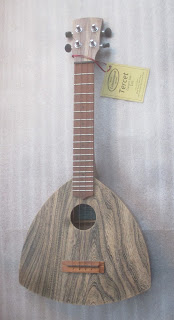I've sold about three dozen Michi-leles, a few to collectors who have more than one or two ukes, but I believe most were bought players who play their Michi-leles on a regular basis. I'm glad to add a Michi-lele to anyone's collection, but I have to emphasize that it is not meant to be merely a display item or conversation piece, it is meant to be played--and happily, as it turns out, the lower Michigan mitten shape makes for an effective sound box. The Michi-lele sounds good.
A few weeks ago Amy, a dedicated uke player--belonging to a large and active ukulele group in Colorado--contacted me by email about a custom-made tenor ukulele, tuned to low-G. I sell thru Etsy and at a retail set-up in my town of Ovid, MI, and I also sell directly to customers led to me thru social media or otherwise. Amy and I had a back-and-forth about the types of wood I had available for her uke (I build with 100% reclaimed wood), I sent her the specs we agreed on via email, and we were off to the races.
The following pix show the building process for Amy's Michi-lele
The main parts before cutting, including the blocks for the body glued up and clamped before the sides are cut out on the band saw..
















